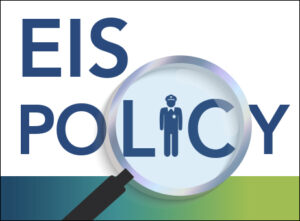Early Intervention Systems: The Impact of Establishing Best Practice Policies
Posted
January 3, 2024
Share:
 Law enforcement personnel have a unique position in our society. They are responsible for the safety and security of all those who reside in, work in, and visit their jurisdictions. As such, they have great responsibility to carry out their duties and exercise their authority within the bounds of established policies and procedures, which are an essential component of any law enforcement agency. Policies address pertinent matters, such as what entails acceptable behavior by employees. Procedures within a policy define a sequence of steps to be followed in a consistent manner — for example, the actions that need to be taken for an out-of-policy event.
Law enforcement personnel have a unique position in our society. They are responsible for the safety and security of all those who reside in, work in, and visit their jurisdictions. As such, they have great responsibility to carry out their duties and exercise their authority within the bounds of established policies and procedures, which are an essential component of any law enforcement agency. Policies address pertinent matters, such as what entails acceptable behavior by employees. Procedures within a policy define a sequence of steps to be followed in a consistent manner — for example, the actions that need to be taken for an out-of-policy event.
As a general roadmap, policies ensure:
- Strategic Alignment: Policies safeguard that law enforcement agencies’ actions are aligned with their mission, goals, and objectives.
- Integrity: Clearly written policies help law enforcement personnel understand agency values and be more responsible for their actions.
- Fairness and Consistency: Policies ensure all law enforcement personnel are treated impartially and in a reasonable manner.
- Efficiency: Setting expectations and rules ahead of time saves time and any costs associated with inefficiencies.
- Safety and Risk Management: Policies can prevent some problems from occurring or getting worse.
Policies and Procedures are Key to your EIS Success
Early Intervention Systems (EIS) are designed to identify officers who may be at risk of incidents, enabling targeted education and support to prevent potential issues. These systems are integral to modern policing strategies, focusing on officer wellness and performance improvement.
Having well-defined policies and procedures around an agency’s Early Intervention System has many important benefits, including:
- Facilitating the prompt review of work-related occurrences involving their personnel that is non-disciplinary in nature.
- Helping supervisory personnel make informed, fair, reasonable, and consistent decisions regarding the behavior and/or performance of their personnel.
- Assisting agencies in exercising their responsibility to identify and support their personnel whose actions or inactions indicate possible stressors and/or need for intervention.
For agencies looking to enlist an Early Intervention System, establishing and maintaining specific EIS policies will improve the likelihood of getting off-track officers back on track; aid supervisors in their planning and support of officers; and build trust that the EIS at its core is a support tool. In the end, it will impact the overall integrity and success of your EIS.
Exploring EIS Policy Best Practices
In Benchmark’s recent installment of our Data Dialogue webinar series, Chief Partnerships Officer Chris Casula led a best-practice discussion on EIS polices. Titled “Early Intervention Systems: Exploring Best Practices for Establishing Your Agency’s Policies”, the webinar included an esteemed panel of agency leaders who have implemented – or currently are implementing – and EIS for their agencies, including Major Mike Harris and Captain Stephen Flatt at Charlotte-Mecklenburg PD; Sergeant Darwin Naval from San Francisco PD; and Senior Corporal Jared Nielsen with Dallas PD.
Each panelist highlighted their department’s unique approach to early intervention, discussing key issues surrounding policy, including:
- Establishing an overall process for prompt review of flagged officers
- Determining key stakeholders
- Categorizing levels of at-risk behaviors
- Developing non-punitive interventions
- And developing training and mentoring resources
Policy in Action — Responding to Alerts
The discussion commenced with a summary of the four prevalent policy and procedural strategies agencies employ when responding to EIS alerts — with panelists weighing in on which one their agency uses and why. The four approaches – which were discussed in-depth in a previous session – include:
- Centralized: A chosen group of department leaders addresses each alert. Although efficient, this method can seem detached in larger agencies.
- Centralized Review: Here, a dedicated risk management team supervises all alerts. While this approach leverages specialized knowledge, it can inadvertently create a divide between the unit and the broader group of officers, possibly engendering an “us vs. them” attitude.
- Decentralized: Here, front-line supervisors are responsible for responding to their officers’ alerts. While fostering close bonds, this might result in inconsistencies due to diverse supervisory styles.
- Capacity Building: This is a combined effort where the risk management team collaborates with supervisors to provide training and expertise in deciphering alerts. It promises consistency and local responsibility, connecting various stakeholders and fostering trust.
Charlotte Mecklenburg PD’s decentralized model empowers the immediate chain of command to address alerts, believing supervisors are best positioned to understand and support their officers. According to Major Mike Harris, Charlotte Mecklenburg PD: “Ours is decentralized, pushing everything to the chain of command because with 1800 officers a centralized EIS couldn’t get to the granular issues like direct supervisors can. It’s meant as an intervention and employee wellness program.”
In contrast, San Francisco PD adopts a hybrid model, combining centralized review with decentralized action, depending on the alert’s severity. Senior Corporal Jared Nielsen, Dallas PD: “The officer’s chain of command reviews the alert and meets with them to create an action plan if needed. The goal is helping officers perform better.” Dallas PD is overhauling its program to transition from a threshold-based model, focusing on supporting officers through various non-punitive measures.
Across the board, panelists emphasized the importance of differentiating EIS from disciplinary measures. The systems are designed to support officers through voluntary training or incremental guidance and assistance, depending on the situation’s specifics. The goal is to help officers perform better and achieve more favorable career outcomes.
Building Trust through Policy Communication
A recurring theme was the need to build trust and ensure communication about the intent of an EIS — before, during and after the implementation process. Educating officers about the non-punitive nature of these systems is crucial. Many officers are unaware of the EIS in their departments, so informing them about its supportive purpose is key. This approach involves offering various options, like training or counseling, to assist officers effectively.
Sergeant Darwin Naval, San Francisco PD: “The biggest obstacle is communicating to officers that the system is non-punitive and supportive. Many don’t know we have an EIS. Educating all levels of the department has been crucial.”
According to Major Harris, “I think the most important thing I’ve learned in developing this program with Benchmark and First Sign is first clearly defining your ultimate goal for your EIS. For us, although the public likes terms like ‘early intervention,’ the backdrop is officer wellness.”
The panelists agreed it’s important that agencies clearly communicate an EIS as a supportive employee wellness initiative rather than a punitive tool. Conveying positive intent behind intervention policies and procedures proves vital for trust, participation, and outcomes. A cohesive internal team for continuity and momentum is recommended for achieving an agency’s communication goals.
EIS Customization and Flexibility is Key
The panelists agreed on the importance of customization and flexibility with an EIS. The systems should be tailored to individual departments and officers’ needs. Rigidity in such programs can be counterproductive. Continuous collaboration between law enforcement agencies and their EIS partner is vital to ensure the systems meet specific requirements and effectively support officers. According to Captain Flatt, “We held classes on the policy and system for all supervisors, stressing its supportive, non-punitive purpose as an early warning tool to make officers better. The flexibility to customize officer action plans has brought surprisingly good ideas from sergeants and lieutenants.”
Customization to each department’s policies, data sources, and localized needs makes platforms markedly more effective than inflexible one-size-fits-all systems. Frequent in-person communication from leadership around the progress and impact of their EIS can also be invaluable.
Addressing Performance and Wellness with Confidence
This final webinar of the year underscored the importance of Early Intervention Systems as a personnel management tool — and how having thoughtful EIS policies and procedures in place will enhance and impact results for your agency. The insights shared by the panelists provide valuable guidance for agencies looking to implement a new EIS.
Enlisting an advanced, data-driven solution like First Sign Early Intervention is crucial for adopting a proactive approach to officer wellness and performance. It goes beyond standard systems by establishing benchmarks that more accurately identify levels of behavior in need of support.
Related Posts
Ready to Experience the Benchmark Difference?
Benchmark Analytics and its powerful suite of solutions can help you turn your agency’s challenges into opportunities. Get in touch with our expert team today.



